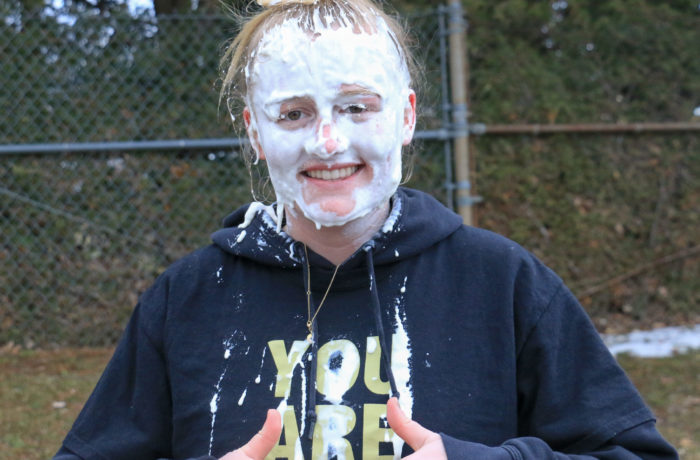
(Matt Heller)
By Lee Krulikowski
Staff Writer
Dotted around campus, galvanized metal and blue plastic buckets hang at a slight tilt from maple trees. Some students have tucked trash into them, assuming they are cleverly placed receptacles. But the buckets are slowly collecting the sap of the warming trees. Every few days a group of students pop by to check on them and pour the bounty into a larger bin to later boil into maple syrup.
After several years of research and experimentation by faculty and staff, St. Michael’s is finally joining the maple community.
The development is currently headed by Krystin Achilich, coordinator of the St. Michael’s farm and professor of environmental studies. Several other faculty members and their classes have also been involved in the process. Karen Popovich, professor of business and accounting, has one of her business classes calculating and balancing the economics. Brian Collier’s environmental art class is creating signs for the trees so that people know what’s going on. Declan McCabe’s biology class is measuring and analyzing the sap output of the trees on campus. The goal of this new agricultural crop at St. Michael’s is to create an interdisciplinary community where everyone on campus can get involved in the act of turning the sap into syrup.
The process is “a ritual at a time when you’re looking for a sense of renewal” said English professor Joan Wry. She’s not directly involved in the process on campus, but she and her husband have been sugaring on their property for a few years, collecting the sap in buckets and evaporating it in their designated turkey fryer.

(Matt Heller)
So far, 18 trees have been tapped, eight by the farm and 10 on main campus. The goal for the future is to tap an even 20. Since the trees in the area are so diverse, there has been trouble finding viable trees for tapping. Although all maple trees produce sap that can be harnessed for this process, the ideal types are red and sugar maples due to their higher sugar-to-water ratio. Furthermore, the trees have to large enough to tap.
“You have to get past a 10-inch diameter to sugar them without injuring them,” McCabe said.
McCabe, coordinator of the Natural Area at St. Michael’s, has several of his biology classes testing the sap production of the trees and their sugar content. He is looking into the amount of viable trees in the Natural Area, and would like to tap trees there by next year.
The ideal weather for tapping the trees are temperatures below freezing at night to keep the sap fresh, and warm days between 40 and 45 degrees so the sap will run. However, with the current temperature drops we’ve been experiencing, the sap run this year has been almost nonexistent.

(Matt Heller)
“This year is a little bit more of a typical winter where we really haven’t made any syrup yet and so we’re going to be in March before the season even starts,’ said Chris White, sixth-generation Vermonter and founder of Mansfield Maple, a local sugaring company and producer. “This season might actually be a lot shorter. You might see a six week long season or shorter.”
Much larger than St. Michael’s, the 10 year old company has their own sugarbush with around 30,000 trees they tap to produce about 17,000 gallons a season. The sap is harvested by the gallons and poured into evaporators to boil down into syrup at their sugar bush. The finished syrup is stored in 40 gallon containers, waiting to be shipped to the Winooski business where it’s canned, bottled, infused, or turned into candy or coffee.
“Maple is a really wonderful product that you can concentrate down to make single ingredient confections. You boil the syrup down and you get maple cream. Keep boiling it and you’re going to end up with a maple candy consistency. Keep boiling and you can get a dry granulated sugar,” White said.
Back on campus, students have unwittingly interfered with the process. Because some don’t understand that the buckets are there for collecting sap, a few have mistakenly used the buckets on the trees as trash receptacles, contaminating the sap. The hope is that the new signs Collier’s class is creating should cease the contamination.
The farm is currently equipped with a small evaporator to boil the sap down to syrup once the sap starts to run. It takes about 40 gallons of sap to create one gallon of syrup.
“This year is all about testing our capacity to do this and collecting some data to implement for later years,” Achilich said. “This project is intended to reach across all kinds of different disciplines.”
The end result for this year will likely end in a pancake party for those involved with the process this year. The long term goal is to create a program where students and faculty across all disciplines can come together for a few months out of the year. Volunteers will be able to help out with the process to make sure the sap doesn’t burn, and create a viable product that can be sold at a decent value.

(Lee Krulikowski)


